Trains are just as American as baseball, hot dogs, and apple pie. What’s even better is combining these. Imagine sitting back in the stands, munching a hot dog, watching a ballgame, and a train rumbles past outside the right-field fence. Could summertime be any better? This is high iron baseball — exploring independent leagues
More than half of the nation’s 240 professional baseball stadiums have a railroad connection — built next to a railroad, located on former railroad land, or are served by rail transit, for example. There are many ballparks where you can see trains from the concourse, but this listing is focused on places with railroad views from the seats.
In this installment, we are focusing on independent league stadiums. These professional teams are not affiliated with any of the Major League organizations and play outside of affiliated Minor League system. For the 2023 season, there are 76 independent teams taking the field in the U.S. and Canada.
We featured Major League and Double-A Minor League train-watching stadiums in the June 2023 issue of Trains. Triple-A stadiums can be found here on Trains.com.
Independent league stadiums
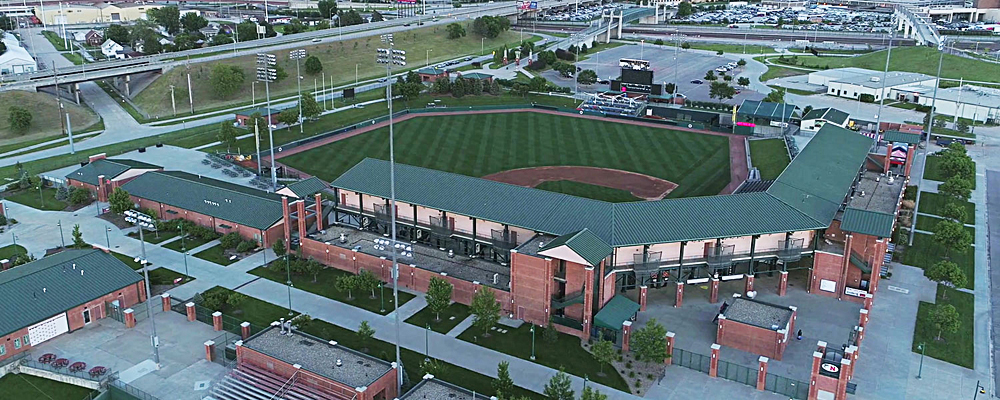
Haymarket Park, Lincoln, Neb.
Lincoln Saltdogs (Independent, American Association)
Trains/day: BNSF Railway: 35-45, Amtrak: 2
Haymarket Park is a baseball stadium with two tenants: the professional Lincoln Saltdogs and the collegiate Cornhuskers from the nearby University of Nebraska. This gives fans more than 75 chances annually to watch baseball and trains at this 2001-built stadium.
Lincoln reconfigured its downtown rail network to free land for development and facilities like Haymarket Park (Missouri Pacific’s former Lincoln Branch ran where the left field concourse stands now). Rail action is concentrated beyond the outfield fence on BNSF’s triple-track Creston Subdivision, which handles rail traffic from the north and east into Lincoln. Lines from Minneapolis, Chicago/Galesburg, and Omaha funnel into Lincoln past the ballpark to BNSF’s Hobson hump yard located west of downtown. Coal and grain unit trains are a large part of the traffic through Lincoln, and fans may also see BNSF shuttling cars to or from its sprawling Havelock car shops located five miles east. Amtrak’s California Zephyr runs past the stadium on BNSF, but after midnight. Southwest of the park, Union Pacific’s Lincoln Subdivision joins BNSF, although UP trains are scarcer and more difficult to see from the ballpark.
Haymarket Park is large (8,500 capacity) for an independent-league ballpark and that size benefits the railfan. Choose seats in the upper deck — third-base side is best — for choice views of the Creston Sub over the outfield walls. There aren’t any road crossings nearby, so fans will need to stay alert to avoid being surprised by approaching trains. Two sets of pedestrian bridges over BNSF connect the stadium area with Lincoln’s downtown and provide good overhead photo angles.
Fun fact:
The Saltdogs’ owner, regional construction and real estate company NEBCO, also runs the local Omaha, Lincoln & Beatrice Railway. OL&B is a former interurban whose “Big Red Line” nickname and football helmet logo honor the hometown Nebraska Cornhuskers football team. OL&B never reached Omaha or Beatrice and now serves customers on 3.6 miles of railroad in Lincoln.
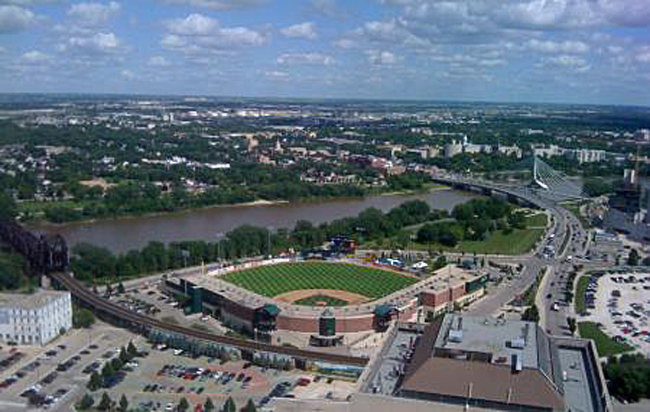
Shaw Park, Winnipeg, Manitoba, Canada
Winnipeg Goldeyes (Independent, American Association)
Trains/day: Canadian National: 35-45, VIA Rail 0-2, Central Manitoba Railway: 0-2
Short summers, lower population density and long distances have helped litter Canada with the tombstones of failed professional baseball teams. But the Winnipeg Goldeyes are a happy exception as they begin their 30th consecutive season in 2023. The Goldeyes’ path has been rocky during the past few years, though: COVID restrictions sent the Goldeyes to Fargo, N.D. for a shortened 2020 season and then the franchise had to call faraway Jackson, Tenn. home until being allowed to return to Winnipeg in August 2021.
The Goldeyes’ return to Winnipeg’s Shaw Park was good news for both baseball fans and train-watchers. Shaw Park is near the heart of downtown, and the attractive stadium has hosted more than four million fans since opening in 1999. Canadian National’s transcontinental main line is the railroad attraction, curving around the stadium, running behind home plate and third base until it crosses the Red River just past the left field foul pole. CN’s Redditt Subdivision is the railway’s primary route through Winnipeg, so baseball fans can witness many kinds of freight trains passing during the game (most with distributed power). Canadian National has a major presence in Winnipeg: the Symington hump yard, Transcona car and locomotive shops and the “CN Campus” training center are all on the east side of Winnipeg. Not to be outdone, Canadian Pacific’s substantial yard and Weston shops are just northeast of Winnipeg’s downtown, but CP trains use their own bridge over the Red River and are not visible from the ballpark.
While train density is high, views from the stadium can be wedgy – choose seats down the first base line for good looks at trains passing behind the third base stands and going over the five-span CN bridge. In addition to CN trains, fans can also see VIA Rail’s biweekly Canadian streamliner coming and going from the grand 1911 Union Station nearby. Short line Central Manitoba Railway (CEMR) also has running rights on CN past the ballpark.
Fun fact:
If you like puns, Winnipeg’s stadium was home to the best-named restaurant in baseball: an Asian bistro called “Hu’s on First.” The restaurant was appropriately located along the first-base line until it was replaced by an Indian eatery in 2013.
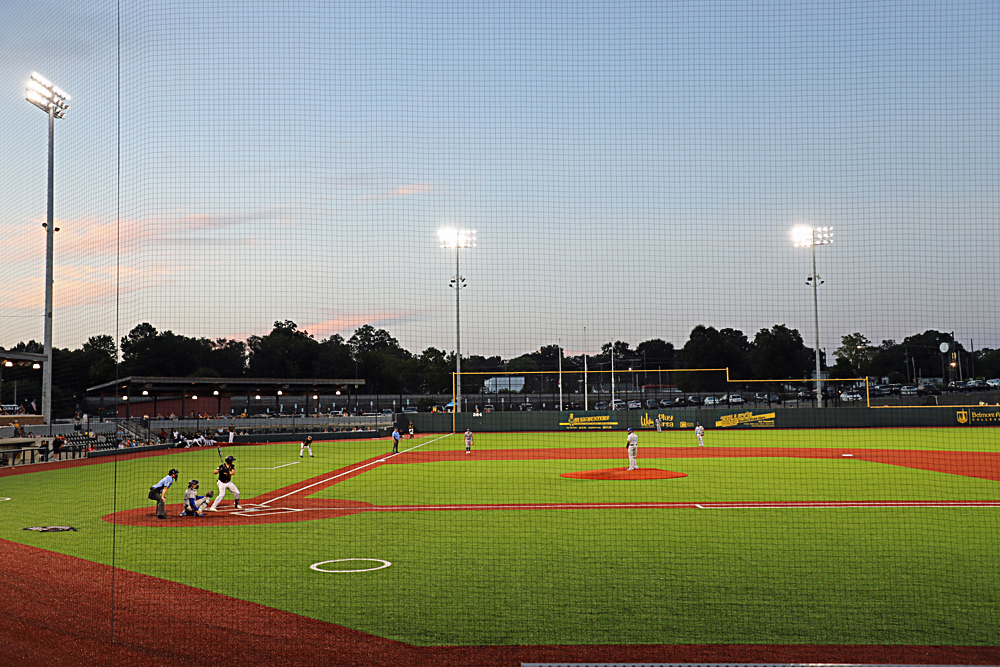
CaroMont Health Park, Gastonia, N.C.
Gastonia Honey Hunters (Independent, Atlantic League)
Trains/day: Norfolk Southern: 15-20, Amtrak: 2
The Gastonia Honey Hunters are new to professional baseball — CaroMont Park and the team both debuted in 2021 — but the ballpark couldn’t be better designed for train-watchers.
Nearly every spot in the 5,000-seat stadium has an excellent view of the Norfolk Southern Charlotte District, which runs behind left field on a slightly elevated fill unblocked by ballpark billboards or scoreboards. This line is the double-track former Southern Railway main line running between Charlotte and Atlanta, which is both fast (intermodal trains are allowed 60 mph) and fairly busy. Intermodal dominates the traffic mix.
Amtrak’s Gastonia stop is two miles to the east and the New York – New Orleans Crescent runs by the stadium. Both Crescents are scheduled in the wee morning hours, so the chance of seeing a passenger train while at the game is slim.
Gastonia is an old textile mill town, and CaroMont Health Park is designed to serve as an anchor for redevelopment of the Franklin Boulevard area on the western edge of Gastonia’s downtown. Gastonia built an intimate stadium, placing all the seating within 10 rows of the field. The open concourse makes it easy to walk around and not miss any baseball or railroad action. Don’t look for Coke or Pepsi at this ballpark – soft drink choices are RC Cola, Sun Drop and local favorite, Cheerwine.
Fun fact:
Electric interurban Piedmont and Northern’s North Carolina Division ran 23 miles between Gastonia and Charlotte. Unlike most interurbans, P&N’s robust freight business enabled the line to last until it was merged into Seaboard Coast Line in 1969. The State of North Carolina now owns the P&N trackage in Gastonia, which is operated as Jaguar Transport’s Charlotte Western Railroad.
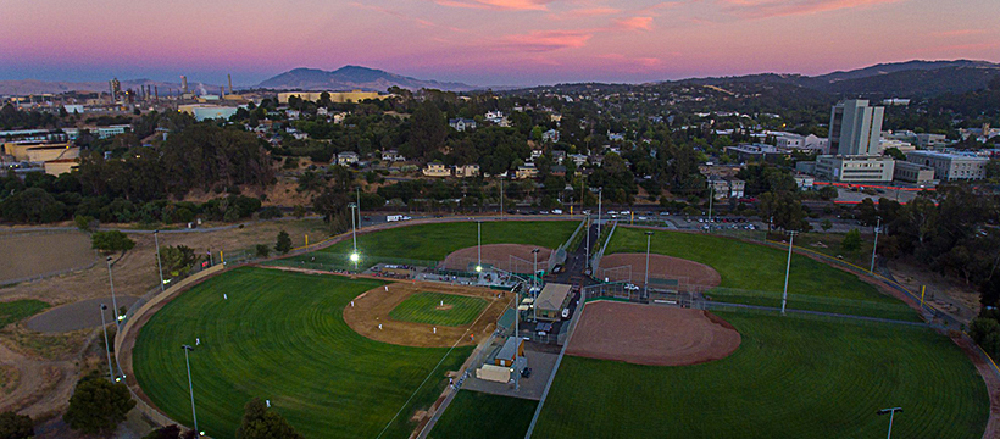
Joe DiMaggio Field, Martinez, Calif.
Martinez Sturgeon (Independent, Pecos League)
Trains/day: Amtrak: 36-38, Union Pacific: 10-15
The Pecos League is professional baseball’s bottom rung in the U.S., the last or only chance for many aspiring players to pursue their baseball dreams. Pecos League players are paid as low as $50 per week — if paychecks come at all — and stadiums are modest at best. The only thing major league about Joe DiMaggio Field is its name, honoring the Martinez-born Hall of Fame “Yankee Clipper.”
But what the field lacks in amenities (yes, there is a grandstand and concessions), it makes up in railroad activity. Wide open views of Union Pacific’s busy Martinez Subdivision are only a few hundred feet away from the first-base line, and the intervening softball field doesn’t block the action. As a bonus, UP’s massive lift bridge (second longest in the country) across the Carquinez Strait is visible behind the outfield. If you see a westbound train moving across the bridge, it will pass the ballfield within a few minutes.
More than 35 daily passenger trains generate most of the railroad action in Martinez. California’s state-supported Capital Corridor (Sacramento) and San Joaquin (Bakersfield) trains use state-branded bilevels powered by F59s and Chargers, while Amtrak’s long-distance California Zephyr and Coast Starlight are Superliner-equipped. Today’s Amtrak station and the 1876 Southern Pacific station are only a few blocks away from the ballpark and plinthed SP 0-6-0 1258 sits at the park entrance.
UP’s former Southern Pacific route is four tracks wide past the ballpark, including two Martinez Sub mainline tracks and the lead to Ozol Yard nearby. The fourth track is UP’s Tracy Subdivision, a crucial connector that allows Amtrak’s San Joaquins to get to their BNSF route down California’s Central Valley to Bakersfield.
Fun fact:
In 2015 the Pecos League and Amtrak announced a partnership for teams to use the Southwest Chief on road trips between Garden City, Kan., Trinidad, Colo., Las Vegas and Lamy (Santa Fe), N.M. Although three of the four teams are still in the Pecos League, little was heard of the partnership since the initial announcement.
Independent league honorable mentions go to the Cleburne, Texas Railroaders whose moniker honors their location in a former Santa Fe shop town. Despite the stadium being named the Depot at Cleburne Junction, it is nowhere near an active rail line. In West Virginia, the Charleston Dirty Birds sound a former Norfolk Southern locomotive horn when the home team blasts one out of the park. In Illinois, the Joliet Slammers and Schaumberg Boomers play in stadiums that are both located next to Chicago-area main lines and Metra stations.
Like this article? Check out “High iron baseball — AAA minor league stadiums”





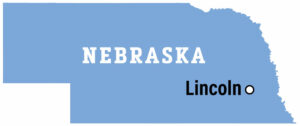
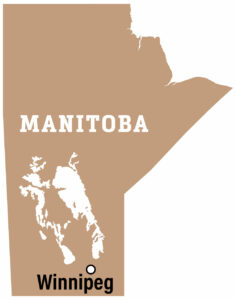
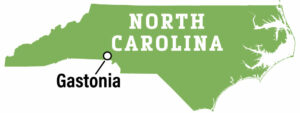
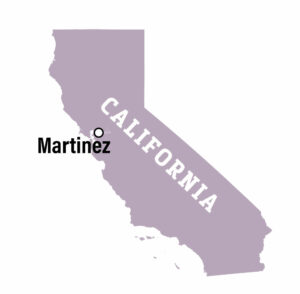

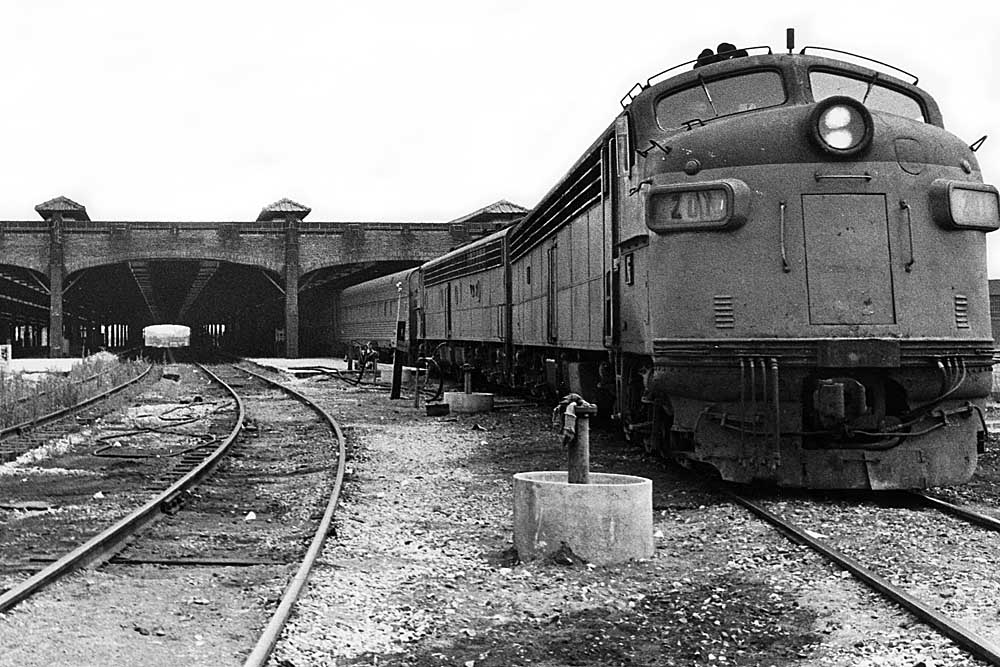







This for INDEPENDENT LEAGUE teams only. No affiliations to any Major League teams.
I am shocked at the failure of this author to fail to include Harbor Park in downtown Norfolk Va., home of the Norfolk Tides, a AAA affiliate of the Baltimore Orioles.(long an affiliate of the NY Mets before that). The NS mainline for it’s “black diamonds” from western Va. and West Va. clatters across an old bascule bridge visible from it’s upper deck past the center field wall to the Lambert’s Point coal piers. The line passes the modern Amtrak station built about a decade ago and hosts 2 outbound and 2 inbound trains to DC daily. Passenger cars are staged on a spur up the line to be readied for the next morning’s (about 6 AM) first trip to the state and US capital. To put icing on the railroad cake, just outside the park is the city’s light rail line called “The Tide” and two stops before it enters city hall plaza and splits the downtown shopping district. The ball park itself is built on the former Norfolk and Western passenger yard and location of it’s iconic station and headhouse which was torn down in the 70s under “urban renewal”. Sadly last year, N&Ws successor Norfolk Southern left Va. and Norfolk all together moving it’s headquarters to Atlanta leaving a special built high rise and parking garage behind. Another NS main line a mile further down, crosses the Elizabeth River on another bascule bridge, is crossed by an overpass by “The Tide” and ends at the Norfolk Marine Terminals, one of the major container ship ports on the east coast and a huge generator of traffic for NS.
What about the South Shore Railcats in Gary, Indiana?
At T-Mobile Park in Seattle, WA the major league Seattle Mariners play. The eastern part of the stadium is very close to the BNSF Seattle Subdivision. If you are out on the concourse or have seats where you can see outside, you can see BNSF, Amtrak, and Sounder commuter trains pass. When the old Kingdome was in existence just north across South Royal Brougham Way, you could walk out on the open concourse and watch the action. This line is very busy through here with 50 plus train movements per day.
The Dragons home field in Dayton Ohio has good view of CSX & NS trackage, which is elevated through town.
The Clinton Iowa Lumber Kings stadium borders on CP’s former Milwaukee Road Kansas City line.
Polar Park in Worcester, MA is home to the Red Sox’ AAA franchise, and adjacent to CSX’s Boston line. When I was there for a Friday night game earlier this month, a westbound CSX manifest crept by. The engineer laid on the horn until the PA announcer finally said “hello train”. Amtrak’s eastbound Lake Shore Limited passed a few minutes later, although with considerably less fanfare.
Dave